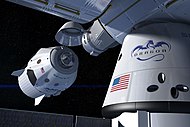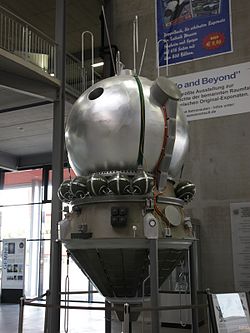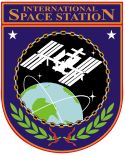SpaceX Crew-1
| SpaceX Crew-1 | |||
 | |||
| Statistik för uppdraget | |||
|---|---|---|---|
| NSSDC-ID | 2020-084A[1] | ||
| Modell | Dragon 2 | ||
| Beställare | NASA | ||
| Operatör | SpaceX | ||
| Farkostens namn | Resilience | ||
| Anrop | Resilience | ||
| Varaktighet | 167 dag, 6 tim, 29 min | ||
| Uppskjutning | |||
| Raket | Falcon 9 Block 5 | ||
| Uppskjutningsramp | Kennedy LC-39A | ||
| Uppskjutning | 16 november 2020, 00:27:17 UTC | ||
| Landning | |||
| Landning | 2 maj 2021, 06:56:33 UTC | ||
| Landningsplats | Mexikanska golfen | ||
| Omloppsbana | |||
| Grader | 51,6° | ||
| Dockning | |||
| Rymdstation | ISS | ||
| Dockning | 17 november 2020, 04:01 UTC | ||
| Port | PMA-2/IDA-2 (Harmony, fram) | ||
| Ur dockning | 5 april 2021, 10:30 UTC | ||
| Andra dockningen | 5 april 2021, 11:08 UTC | ||
| Port | PMA-3/IDA-3 (Harmony, zenit) | ||
| Andra ur dockning | 2 maj 2021, 00:35 UTC | ||
| Besättning | |||
| Befälhavare | Michael S. Hopkins (2) | ||
| Pilot | Victor J. Glover (1) | ||
| Uppdragsspecialister | Soichi Noguchi (3) Shannon Walker (2) | ||
 Walker, Glover, Hopkins, Noguchi | |||
| Kronologi | |||
| |||

SpaceX Crew-1 är uppdragsbeteckningen för den andra bemannade rymdfärden med en Dragon 2-rymdfarkost från SpaceX. Farkosten sköts upp med en Falcon 9-raket från Kennedy Space Center LC-39A den 16 november 2020. Flygningens destination var den Internationella rymdstationen (ISS).[2] Farkosten dockade med rymdstationen den 17 november 2020.
Efter dockningen blev besättningen del av Expedition 64s arbete ombord på rymdstationen.[2]
Den 5 april 2021 flyttade man farkosten från Harmony modulens främre dockningsport till zenit dockningsporten på samma modul.
Farkosten lämnade rymdstationen den 2 maj 2021, några timmar senare återinträdde den i jordens atmosfär och landade man Mexikanska golfen.
Besättning
| Befälhavare | Hans andra rymdfärd |
|---|---|
| Pilot | Hans första rymdfärd |
| Flygingenjör 1 | Hans tredje rymdfärd |
| Flygingenjör 2 | Hennes andra rymdfärd |
Backup
| Befälhavare | |
|---|---|
| Flygingenjör 1 |
Källor
- ^ ”NASA Space Science Data Coordinated Archive” (på engelska). NASA. https://nssdc.gsfc.nasa.gov/nmc/spacecraft/display.action?id=2020-084A. Läst 23 november 2020.
- ^ [a b] Marie Lewis (10 oktober 2020). ”NASA, SpaceX Crew-1 Launch Update” (på engelska). NASA. https://blogs.nasa.gov/commercialcrew/2020/10/10/nasa-spacex-crew-1-launch-update/. Läst 6 november 2020.
| ||||||||||||||||||||||||||||||||||||||||||||||||||||||||
| |||||||||||||||||||||||||||||||
| ||||||||||||||||||||||||||||||||
Media som används på denna webbplats
Författare/Upphovsman: Pascal (Flickr user: pasukaru76), Licens: CC0
Vostok spacecraft replica at the Technik Museum Speyer, Germany.
Författare/Upphovsman: SpaceX, Licens: CC0
From left, Mission Specialist Shannon Walker, Pilot Victor Glover, Crew Dragon Commander Michael Hopkins– all NASA astronauts – and Japan Aerospace Exploration Agency (JAXA) astronaut and Mission Specialist Soichi Noguchi are seated in SpaceX’s Crew Dragon spacecraft during crew equipment interface training. Walker, Glover, Hopkins, and Noguchi will launch to the International Space Station on the agency’s SpaceX Crew-1 mission. This will be the first operational mission to the orbiting laboratory under NASA’s Commercial Crew Program following the agency’s certification of SpaceX’s crew transportation system. The crew will launch from Kennedy Space Center’s Launch Complex 39A inFlorida.
In this illustration, a SpaceX Crew Dragon spacecraft approaches the International Space Station for docking. NASA is partnering with Boeing and SpaceX to build a new generation of human-rated spacecraft capable of taking astronauts to the station and expanding research opportunities in orbit. SpaceX's upcoming Demo-1 flight test is part of NASA’s Commercial Crew Transportation Capability contract with the goal of returning human spaceflight launch capabilities to the United States.
Författare/Upphovsman: SpaceX, Licens: CC0
This artist's concept shows a SpaceX Crew Dragon docking with the International Space Station as it will during a mission for NASA's Commercial Crew Program. NASA is partnering with Boeing and SpaceX to build a new generation of human-rated spacecraft capable of taking astronauts to the station and expanding research opportunities in orbit.
Backdropped by a blue and white Earth, this close-up view features the Soyuz TMA-6 spacecraft approaching the International Space Station (ISS). Onboard the spacecraft are cosmonaut Sergei K. Krikalev, Expedition 11 commander representing Russia's Federal Space Agency; astronaut John L. Phillips, NASA ISS science officer and flight engineer; and European Space Agency (ESA) astronaut Roberto Vittori of Italy. The Soyuz linked to the Pirs Docking Compartment at 9:20 p.m. (CDT) on April 16, 2005 as the two spacecraft flew over eastern Asia. The docking followed Friday’s launch from the Baikonur Cosmodrome in Kazakhstan.
Författare/Upphovsman: Space Exploration Technologies Corp., Licens: CC0
The 2018 version of the Big Falcon Rocket at stage separation: Starship (foreground) and Super Heavy (background)
The SpaceX Crew-2 official insignia
- The determined expression of the Dragon reflects the strength of the team and their contribution to the exploration of space. The five large stars represent the five partner space agencies coopering the International Space Station program. Designed by Gregory Manchess
Crew poster of the SpaceX Crew-1 mission.
Rotated and color enhanced version of original (ISS013-E-48788 (6 July 2006) --- The Space Shuttle Discovery approaches the International Space Station for docking but before the link-up occurred, the orbiter went through a series of inspection photos by station crew to inspect the vehicle for any damage to its Thermal Protection System. This was known as the Rendezvous Pitch Maneuver and was implemented after the Columbia Disaster in 2003. The Leonardo Multipurpose Logistics Module can be seen in the shuttle's cargo bay. Discovery docked at the station's Pressurized Mating Adapter 2 at 9:52 a.m. CDT, July 6, 2006.)


















